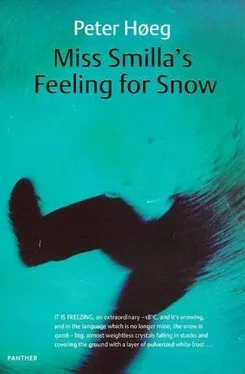Peter Høeg - Smilla's Sense of Snow aka Miss Smilla's Feeling for Snow
Здесь есть возможность читать онлайн «Peter Høeg - Smilla's Sense of Snow aka Miss Smilla's Feeling for Snow» весь текст электронной книги совершенно бесплатно (целиком полную версию без сокращений). В некоторых случаях можно слушать аудио, скачать через торрент в формате fb2 и присутствует краткое содержание. Жанр: Современная проза, на английском языке. Описание произведения, (предисловие) а так же отзывы посетителей доступны на портале библиотеки ЛибКат.
- Название:Smilla's Sense of Snow aka Miss Smilla's Feeling for Snow
- Автор:
- Жанр:
- Год:неизвестен
- ISBN:нет данных
- Рейтинг книги:3 / 5. Голосов: 1
-
Избранное:Добавить в избранное
- Отзывы:
-
Ваша оценка:
- 60
- 1
- 2
- 3
- 4
- 5
Smilla's Sense of Snow aka Miss Smilla's Feeling for Snow: краткое содержание, описание и аннотация
Предлагаем к чтению аннотацию, описание, краткое содержание или предисловие (зависит от того, что написал сам автор книги «Smilla's Sense of Snow aka Miss Smilla's Feeling for Snow»). Если вы не нашли необходимую информацию о книге — напишите в комментариях, мы постараемся отыскать её.
Smilla's Sense of Snow aka Miss Smilla's Feeling for Snow — читать онлайн бесплатно полную книгу (весь текст) целиком
Ниже представлен текст книги, разбитый по страницам. Система сохранения места последней прочитанной страницы, позволяет с удобством читать онлайн бесплатно книгу «Smilla's Sense of Snow aka Miss Smilla's Feeling for Snow», без необходимости каждый раз заново искать на чём Вы остановились. Поставьте закладку, и сможете в любой момент перейти на страницу, на которой закончили чтение.
Интервал:
Закладка:
For me, too. The only other thing I have left is my ability to distance myself.
This is happening to me; the pain is mine, but it doesn't completely absorb me. Part of me remains a spectator. I crawl into the dumbwaiter. It hasn't gotten any easier since yesterday. I'm not getting any younger, after all.
Now I'm glad that there's no safety device. This dangerous system allows me to press the Up button myself. The rush of fear during the ascent up the shaft is still the same. As is the silence at the top. And the empty kitchen.
The moon is shining through the skylight. On my way to the door I have a vision of myself as I must look from outside. Clad in black, but as pale as a white-faced clown.
There are the same sounds in the corridor. The engines, the toilets, a woman's breathing. It's as if time has stopped.
The moonlight streaming into the salon is blue and palpably cold, like a liquid against my skin. The rolling of the ship on the waves makes the silhouettes of the window ledges stretch out like living shadows across the walls.
I head for the books first.
The Greenlandic Pilot, the Geodetic Institute's mapbook of Greenland, the admiralty's sea charts of Davis Strait, reduced 4:1 and collected in a single volume. Colbeck's Dynamics of Snow and Ice Masses, on the movements of ice. Buchwald's Meteorites in three volumes. Issues of Naturens Uerden and Varv. The Review of Medical Microbiology by Jawetz and Melnick. Rintek Madsen's Parasitology-A Handbook. Dion R. Bell's Lecture Notes on Tropical Medicine.
I put the latter two volumes on the floor and leaf through them with my right hand, holding, my flashlight in my left. Under the heading Dracunculus so many passages are highlighted in yellow that it looks as if the paper has changed color. I put the books back in place.
Out in the hallway I listen intently at each door. By sheer accident I locate Tørk's cabin on the first try. I open the door a crack. Moonlight is shining through the porthole and across the bunk. It's cold in the room, but he has pushed the comforter aside. His torso looks like bluetinged marble. He's sleeping heavily. I step inside and close the door behind me. What complicates life is having to make choices. The person who is pushed forward lives simply.
Everything takes care of itself. He had been working at the desk. The writing implements were put away, since on a ship everything that might roll around has to be stowed. But his papers are still lying there. A stack of them, but not too big for me to carry.
I stand there for a moment, looking at him. Like so many times before, ever since my childhood, I marvel at the chaste vulnerability of human beings in sleep. I could bend over him. I could kiss him. I could feel his heartbeat. I could slit his throat.
I suddenly realize that in my life I am often awake while other people sleep. I've been through many late nights and many early mornings. I didn't plan it that way. But that's how it turned out.
I take the stack of papers out to the salon. There won't be time to take them along when I leave.
I sit there for a moment without turning on the light. A sense of solemnity has come over the room. As if the moonlight had encapsulated everything in bluish-gray glass.
Everyone dreams of finding the key to oneself and one's future. The religious classes at Sunday school in Qaanaaq were taught by a catechist from the Moravian mission, an introverted and brutal Belgian mathematician who didn't know one word of the Thule dialect. The lessons were given in a grotesque hodgepodge of English, West Greenlandic, and Danish. He scared us but also fascinated us. We were brought up to respect the profundity that is sometimes found in madness. Sunday after Sunday he would dwell on two things: the newly discovered Nag Hammadi canon's commandment to know thyself and the idea that our days are numbered, that there is a divine arithmetic in the universe. We were all between five and nine years old. We didn't understand a word. Yet I still remembered various things later on. I especially thought that I'd like to see the cosmic calculation for my own life.
Every once in a while it feels as if that moment has arrived. Just like now. As if this stack of papers in front of me has something vital to tell me about my future.
My mother's forefathers would have been astounded that the key to the universe for one of their descendants would turn out to be in written form.
On top there is a copy of the Cryolite Corporation of Denmark's report on the 1991 expedition to Gela Alta. The last six pages are not copies. They are the original, slightly blurry, and technically flawed aerial photos of the Barren Glacier. It lives up to its reputation: arid, cold, white, worn, windblown, and abandoned even by the birds.
Then there are a couple of dozen handwritten pages with figures and small pencil sketches that are incomprehensible.
Twelve photographs are reprints of X-rays. They might be the same people I once looked at on the light box in Moritz's consultation room. They might be anything at all.
There are more photos. These might have been taken by X-ray, too. But the images are not of the human body.
Straight black and gray lines have been drawn across the pictures, as if made with a ruler.
The last pages are numbered from 1 to 50 and are all part of a single report.
The text is sparse, the numerous pen-and-ink drawings are sketchy; calculations have been added by hand in several places when the typewriter couldn't supply the proper symbols.
It's a compilation of data pertaining to the transport of large objects across ice. With sketches of the procedures and brief, illustrative equations regarding the mechanical specifications.
There's a summary about the use of heavy sleds on expeditions to the North Pole. A series of drawings demonstrate the way ships were pulled across the ice to avoid being frozen solid in it.
Several sections of the report have short titles such as: "Ahnighito, Dog, Savik 1, Agpalilik." They concern the transport of the largest-known fragments of meteorites from the Cape York site, Peary's difficult salvage operations and voyage on the schooner Kite, Knud Rasmussen's logbook, and Buchwald's legendary transport of the 30-ton Ahnighito in 1965.
This last section contains copies of Buchwald's own photographs. I've seen them many times before; they've been included in every article on the subject for the past twenty years. And yet it still seems as if I'm seeing them for the first time. The chutes made from railroad ties. The winches. The crudely welded sleds made of train tracks. The photocopies make the contrast too extreme and blur the details. And yet it's all so obvious. The Kronos is carrying a duplicate of Buchwald's equipment in the aft cargo hold. The meteorite that he transported to Denmark weighed 30.88 tons.
The last part of the report deals with the joint Danish, American, and Soviet plan for a drilling platform on the ice. The Pylot Report on the bearing capacity of ice is mentioned in the list of references. My name is in the list of authors.
At the bottom of the stack of papers there are six color photos. They were taken with a flash in some kind of stalactite cave. Every student of geology has seen similar pictures. The salt mines in Austria, the blue grottoes on Sardinia, the lava caves on the Canary Islands.
But these are different. The light of the flash has been thrown back toward the lens in blinding reflections. As if it were a picture of a thousand small explosions. The photograph was taken in an ice cave.
The ice caves that I've seen have all had an extremely short lifetime, lasting only until the break in the glacier or the crevasse closed, or they were filled up by underground rivers of thawing ice. This one is not like anything I've ever seen before. Long, glittering stalactites hang from the ceiling everywhere, a colossal system of icicles that must have been formed over a long period of time.
Читать дальшеИнтервал:
Закладка:
Похожие книги на «Smilla's Sense of Snow aka Miss Smilla's Feeling for Snow»
Представляем Вашему вниманию похожие книги на «Smilla's Sense of Snow aka Miss Smilla's Feeling for Snow» списком для выбора. Мы отобрали схожую по названию и смыслу литературу в надежде предоставить читателям больше вариантов отыскать новые, интересные, ещё непрочитанные произведения.
Обсуждение, отзывы о книге «Smilla's Sense of Snow aka Miss Smilla's Feeling for Snow» и просто собственные мнения читателей. Оставьте ваши комментарии, напишите, что Вы думаете о произведении, его смысле или главных героях. Укажите что конкретно понравилось, а что нет, и почему Вы так считаете.




![Рута Шепетис - Ashes in the Snow [aka Between Shades of Gray]](/books/414915/ruta-shepetis-ashes-in-the-snow-aka-between-shades-thumb.webp)







